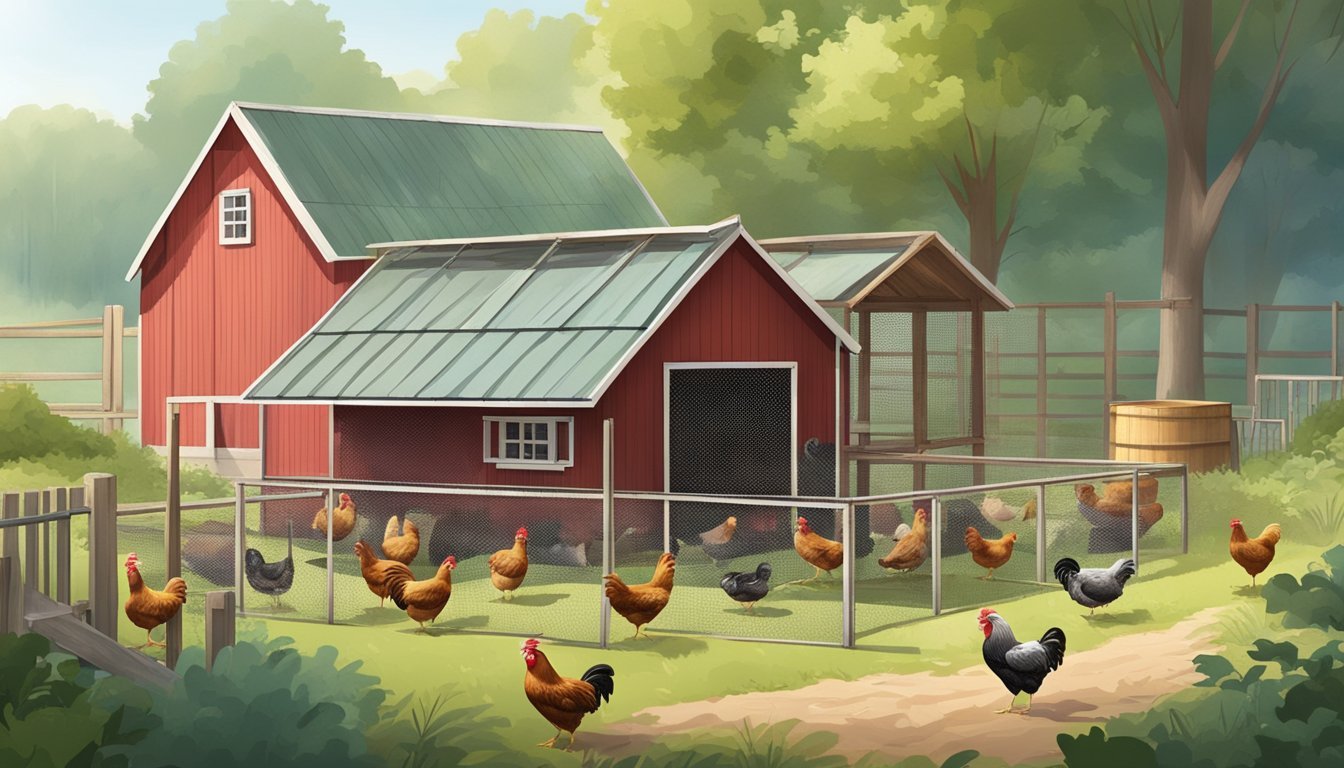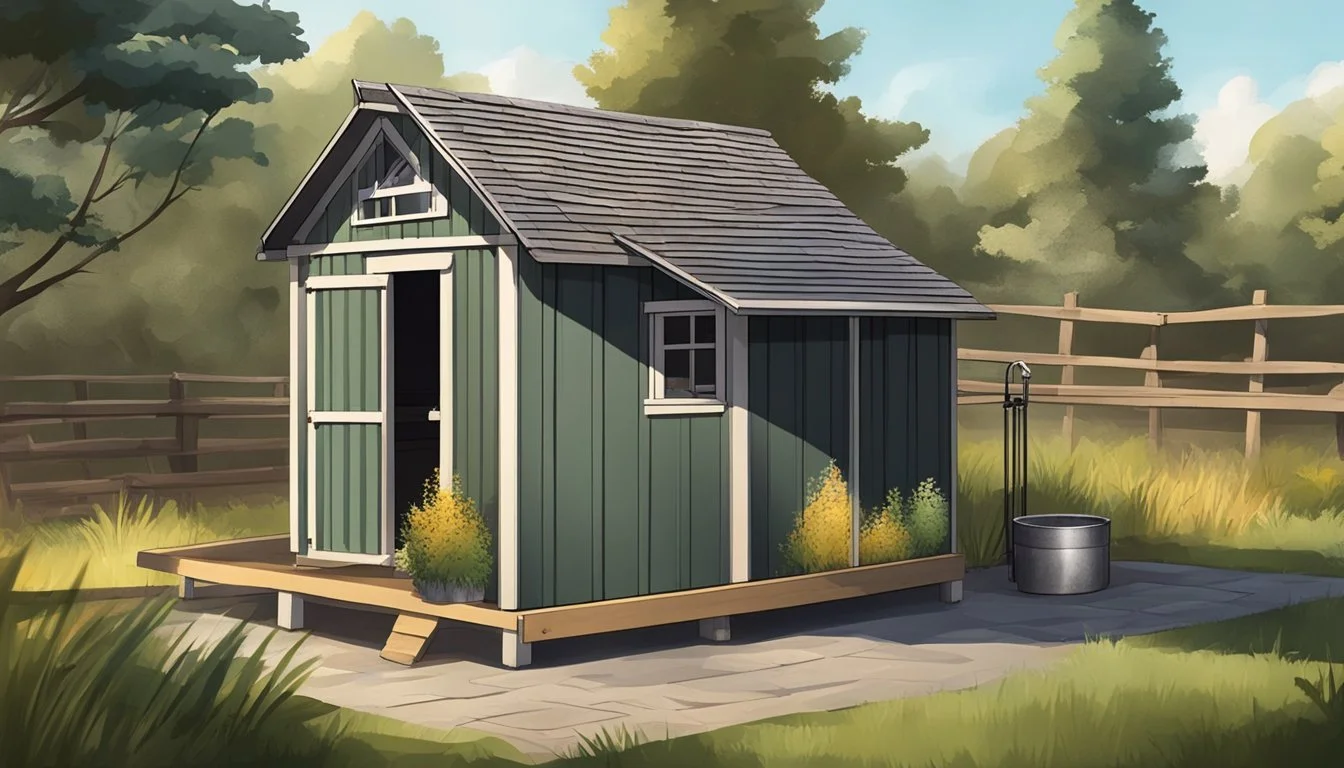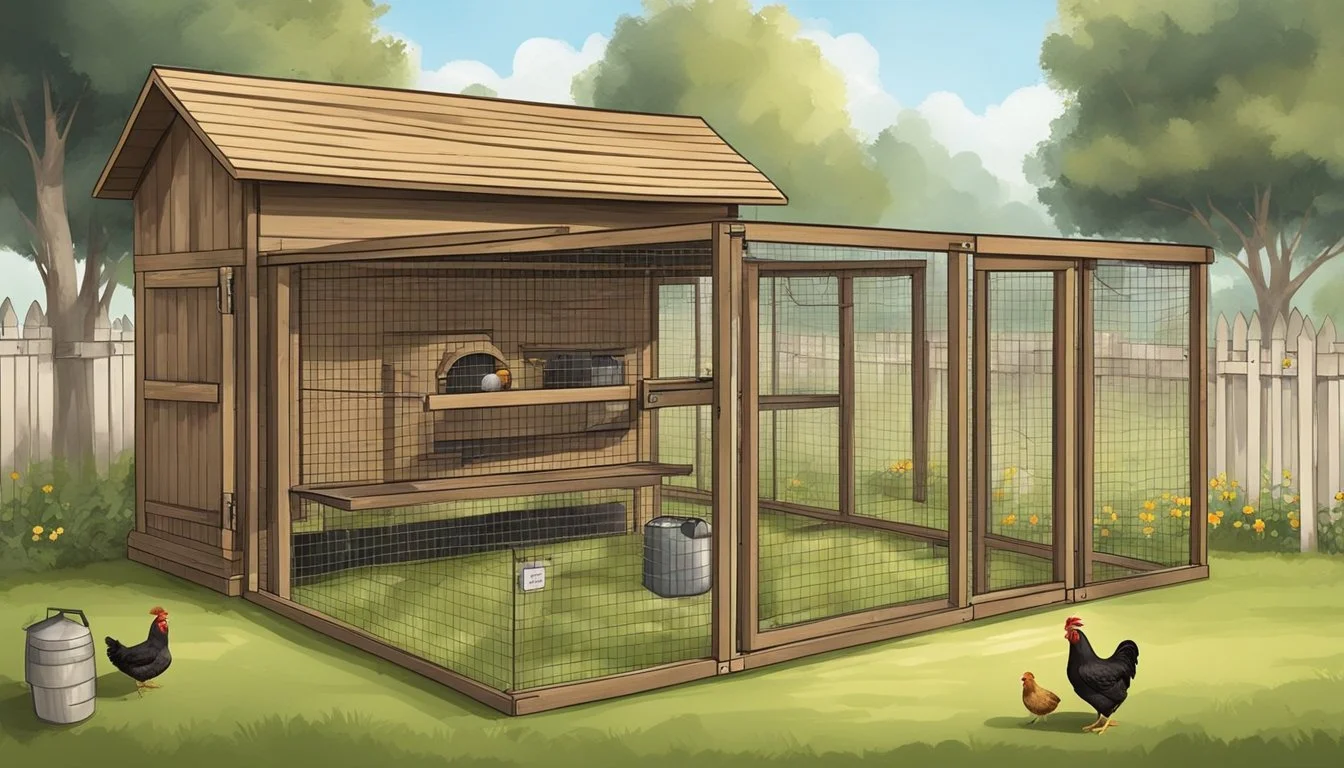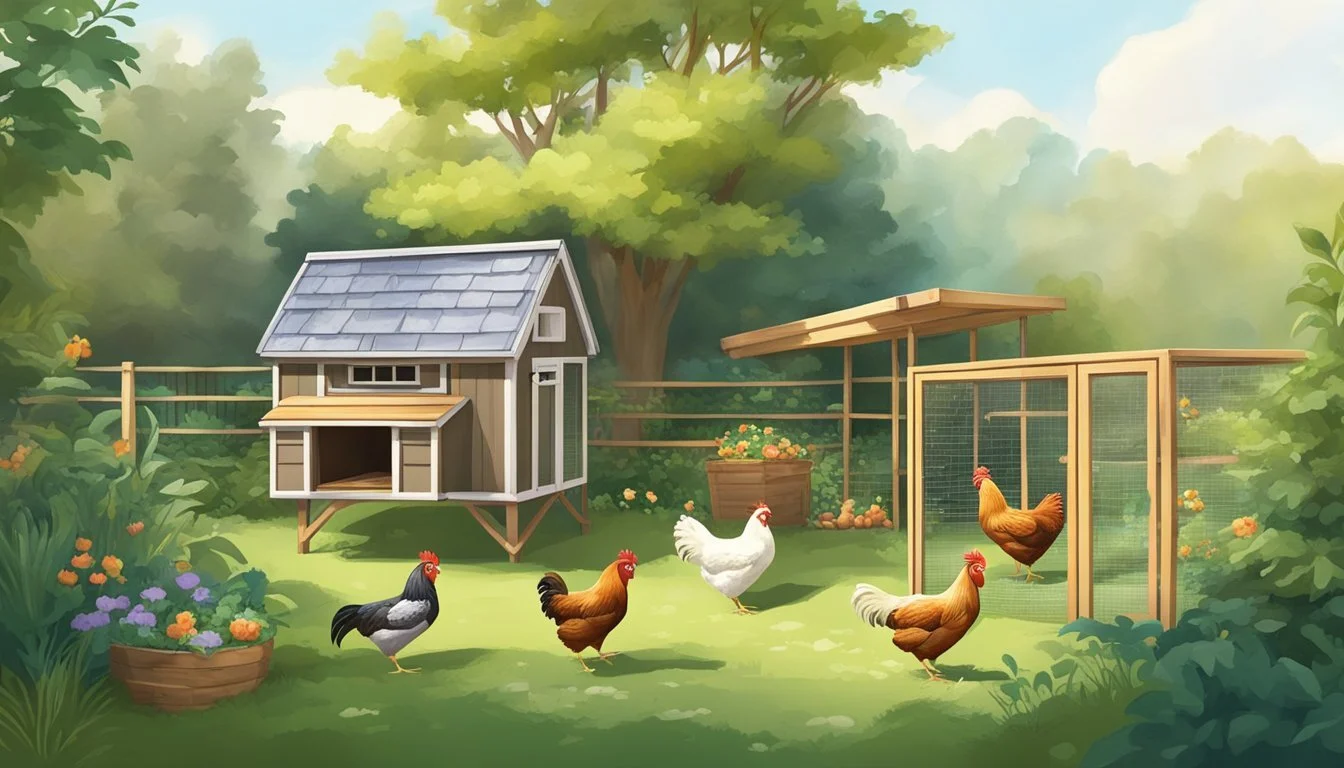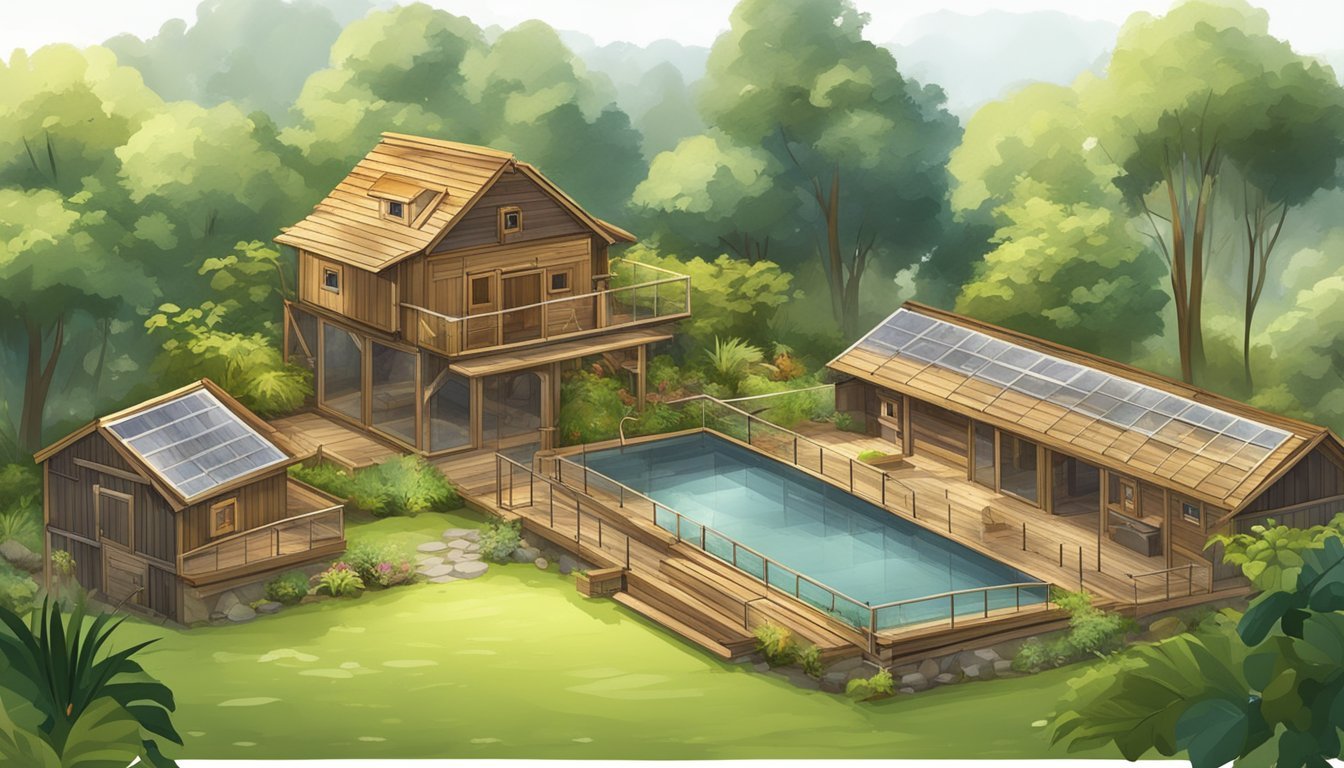Chicken Coop Ideas
Innovative Designs for Happy Hens
Raising backyard chickens has become increasingly popular in recent years, leading to a growing demand for innovative and efficient chicken coop designs. A well-constructed coop not only provides a safe and comfortable environment for the birds but also adds aesthetic appeal to your backyard. With numerous chicken coop ideas and options available, it's essential to consider the specific needs of your flock and the environmental conditions of your property when making a decision.
There are various styles and sizes of chicken coops that cater to different preferences and varying flock sizes, from a beautiful chicken coop for stylish chicken owners to a charming chicken coop for a flock of chickens. Some prefer a simple and compact design, while others lean towards an elaborate and spacious structure, complete with nesting boxes, roosting bars, and exterior nesting boxes for ample ventilation and easy-to-clean features. Additionally, incorporating material lists and proper ventilation ensures a healthy living space for the chickens throughout the varying seasons, whether it's a movable chicken coop or a stationary one.
One popular trend in chicken coop ideas is the upcycling of existing materials, such as pallets and repurposed furniture, to create unique and functional coops. This eco-friendly approach not only contributes to a reduced environmental impact, but can also be a cost-effective solution for those on a budget. With a balance between functionality and style, backyard chicken keepers can foster a thriving flock through well-thought-out chicken coop designs.
Essentials of Chicken Coop Design
A well-designed chicken coop is essential for the health and wellbeing of your flock, ensuring that chickens have plenty of light and feet of floor space to keep them happy. In this section, we will discuss the key elements of a functional and efficient chicken coop design, whether it's a custom coop for cold climates or a backyard coop designed with efficiency in mind.
First and foremost, proper ventilation is crucial for maintaining clean air and keeping the coop's internal temperature at an appropriate level, especially in cold winters. Ensure that your coop has multiple vents or windows, which should be covered with hardware cloth to prevent predators from gaining access. Including a vent on the high side of the coop will allow hot air to escape, while a vent on the low side will draw in fresh air, keeping the chickens plenty comfortable.
Selecting the right materials for your chicken coop will help ensure durability and ease of maintenance, such as using wooden floor and roof panels for added insulation. For walls and fencing, chicken wire is a popular choice, as it is relatively inexpensive and offers reasonable protection. However, hardware cloth with 1/2-inch openings is an even stronger option, providing a higher level of security against predators. Additionally, considering customization options and including tool lists for construction can help you create a custom coop that meets the specific needs of your flock.
In terms of layout, aim to create a functional and comfortable space for your chickens. Here are some factors to consider:
Size: Provide at least 3-4 square feet of space per chicken inside the coop and 10 square feet in the outside run.
Flooring: The coop should have a raised floor to prevent damp conditions and provide better insulation. Include a layer of bedding such as pine shavings or straw.
Roosting poles: Chickens prefer to roost off the ground at night, so accommodate these preferences by installing roosting poles at varying heights.
Nesting boxes: One nesting box per every 3-4 chickens accommodates egg-laying. The boxes should be placed in a dark and quiet area of the coop.
Finally, consider adaptability and expansion when designing your chicken coop. Choose a design that can be easily modified should you decide to add more chickens to your flock in the future. Including features such as removable dividers and expansion-ready outer structures can save time and effort later.
By carefully considering these essential aspects of chicken coop design, you can create a safe, comfortable, and efficient space for your chickens to thrive.
Choosing the Right Location
Choosing the right location for a chicken coop is crucial for the health and safety of your flock. When selecting a spot, consider a location that is at least 4 feet wide and 4 feet tall, providing ample space for the coop and ensuring that the chickens have enough room to move around comfortably. Additionally, ensuring sufficient ventilation and plenty of nesting boxes is essential for a backyard chicken coop, as it provides the chickens with a healthy and comfortable living environment.
If you opt for a Mobile Chicken Coop, make sure to choose a location that allows for easy movement and access. Lastly, a stylish chicken coop can enhance the overall aesthetic of your property while providing a functional and comfortable space for your flock.
When planning to build a backyard chicken coop, one of the most important steps is choosing the right location for it. A well-selected spot not only keeps your chickens comfortable but also ensures their overall health and well-being. Consider the following factors before deciding on the perfect site:
Accessibility: Ensure that the coop location is easy to access regularly throughout the year. This will make cleaning, feeding, and egg collection simpler for you.
Shade: Chickens need protection from direct sunlight, especially during the hot summer months. Locate the coop under trees or install a shade structure. However, ensure that there is still proper ventilation and natural light throughout the day.
Drainage: Opt for an area with a slight slope to avoid water pooling within the coop. Good drainage is essential for preventing issues like bacteria buildup and mold growth.
Predator Protection: Choose a spot that provides natural barriers against predators, such as fences or bushes. In addition, the coop itself should have a secure design to keep your chickens safe.
Size: Keep in mind the potential size of your flock when deciding on the location. More chickens require a larger coop and more outdoor space for roaming.
Here is a summary of the key factors to consider when choosing a coop location:
Factor: Accessibility
Why it's important: Facilitates cleaning, feeding, and egg collection
Factor: Shade
Why it's important: Protects chickens from direct sunlight, ensures proper ventilation
Factor: Drainage
Why it's important: Helps prevent water pooling, bacteria buildup, and mold growth within the coop
Factor: Predator Protection
Why it's important: Provides additional security against predators by utilizing natural barriers
Factor: Size
Why it's important: Ensures ample space for the coop and outdoor roaming area for chickens
Once you have considered these factors and chosen the ideal spot, you can proceed with designing and constructing the chicken coop that meets the unique needs of your flock. Remember, a well-planned and located coop makes for happy and healthy chickens.
DIY Chicken Coop Plans
DIY chicken coop plans are a great way to create a customized living space for your flock. When designing your coop, it's important to ensure that there is at least 4 square feet of floor space per chicken, along with plenty of ventilation to maintain a healthy environment. Additionally, incorporating sufficient nesting boxes and ample ventilation is essential for the comfort and well-being of your chickens. If you're considering a Mobile Chicken Coop, be sure to factor in portability and easy access when developing your DIY plans.
Free Chicken Coop Plans
You can find numerous free chicken coop plans available online. Websites specializing in DIY projects and homesteading are excellent resources to find plans that cater to different skill levels and budget constraints. Some popular sites include:
Backyard Chickens
My Outdoor Plans
The Garden Coop
Make sure to review the plans thoroughly and choose the one that best suits your needs and preferences. Consider factors such as the number of chickens, the available space, and potential predators when selecting a plan.
DIY Chicken Coop Plan
A DIY chicken coop plan should provide clear and concise instructions to guide you through each step of the construction process. A comprehensive plan typically includes:
Blueprints: Detailed drawings or diagrams depicting the design, layout, and dimensions of the coop.
Steps: Sequential procedures to follow during the construction process, with corresponding images or illustrations for better understanding.
Measurements: A list of accurate measurements for cutting and assembling materials. This helps ensure a precise fit and reduces errors during construction.
Before starting, go through the entire plan and make sure you understand it fully. This will allow you to identify potential challenges and make any necessary modifications to suit your needs.
Materials Lists
Along with your chosen chicken coop plan, a materials list is a crucial element of any successful DIY project. A comprehensive list should include the following information:
Material Type: Lumber
Quantity: 4
Dimensions: 2x4x8
Additional Details: Pressure-treated
Material Type: Plywood
Quantity: 2
Dimensions: 4x8x3/4
Additional Details: Exterior grade
Material Type: Hardware Cloth
Quantity: 1
Dimensions: 36"x25'
Additional Details: 1/2" mesh
Material Type: Specify what type of material is needed, such as lumber, plywood, or hardware cloth.
Quantity: Indicate the number of each material needed for your project.
Dimensions: Provide accurate measurements for each material to ensure a proper fit during construction.
Additional Details: Include other important information such as the type of lumber or any required treatments.
Once you have your materials list, gather everything you need before beginning the project. This will save you time and help ensure a smoother construction process.
Securing Your Coop
Securing your chicken coop is essential for the safety and well-being of your flock. It's important to ensure that there is plenty of ventilation while also implementing measures to safeguard the coop from predators. Whether you have a finished coop or are in the process of constructing one, incorporating creative chicken coop ideas can help enhance the security and aesthetics of the coop, providing a good-looking chicken house that keeps both the chickens and chicken lovers happy. Additionally, for added protection, consider an Elevated chicken coop to deter potential threats and keep your chickens safe and secure.
Ensuring the safety of your chickens should be a top priority when setting up your chicken coop. Chickens need a secure and comfortable space to thrive, and protecting them from predators and harsh weather conditions is of utmost importance. The following are some key considerations to keep in mind while securing your chicken coop.
Location: Choose a location that offers both a natural barrier and easy access for you. Placing the coop near trees or a fence can provide additional protection against predators. Also, consider placing the coop in a highly visible area where you can easily monitor it.
Chicken Run: A chicken run is a fenced, outdoor area where chickens can roam and get exercise. Having a run that's well-secured can help prevent predator attacks. Use hardware cloth with small openings (1/2 inch or less) to enclose the run, and bury it about 12 inches into the ground to deter digging predators. Additionally, placing a secure cover over the run will keep birds of prey from attacking your chickens.
Here's a comparison of two materials often used in coop construction, highlighting their pros and cons:
Material: Hardware Cloth
Pros: Strong, small openings, durable
Cons: More expensive
Material: Chicken Wire
Pros: Budget-friendly, easy to install
Cons: Larger openings, less secure
Hardware: Quality and durability are essential factors to consider when purchasing hardware for your coop. Invest in heavy-duty locks, hinges, and latches that can withstand the onslaught of a determined predator. It's a good idea to use combination padlocks to prevent raccoons from easily opening doors.
Coop Design: Carefully design your coop with security in mind. The structure should be built with strong materials such as hardwood or metal. Ensure that all windows and vents are properly covered with hardware cloth to prevent any predators from gaining access. Installing a screen or mesh flooring in raised coops can also help fend off any digging predators.
Lighting: Installing motion-activated lights around your coop can help deter predators, as they generally fear being exposed. Additionally, it allows you to quickly spot and address any potential threats.
Proper planning and taking preventative measures are the keys to safely securing your chicken coop. Paying attention to location, run security, hardware, coop design, and lighting will help create a safe environment for your chickens, allowing them to thrive.
Styles of Chicken Coops
Styles of chicken coops vary widely, offering different features to suit the needs of both chickens and their owners. Some coops feature a chicken-sized door for easy access for the flock, while others may have cabinet-style doors for convenient storage of supplies.
Additionally, incorporating human-sized doors can make cleaning and maintenance more manageable, providing easy access for chicken owners. When considering styles, it's important to factor in building costs and construction costs, as well as the list of materials used, to identify potential cost savings and ensure that the chosen style meets both functional and budgetary requirements.
Modern Chicken Coop
The modern chicken coop is often characterized by its sleek design and eco-friendly materials. This style focuses on blending aesthetics with functionality, providing clean lines and minimalistic features. You will often find angular shapes, large windows for natural light, and space-efficient nesting areas. A modern chicken coop may also incorporate green technologies, such as solar panels or rainwater collection systems, to reduce its environmental impact. Some examples of a modern chicken coop include:
Shed chicken coop: This features a simple, rectangular design with a slanted roof, making it easy to build and maintain.
Chicken barn: This offers a more spacious area for your chickens to roam, boasting multiple flop levels and additional storage options.
A-Frame Chicken Coop
The A-Frame chicken coop is a popular choice due to its simple construction and affordability. As the name suggests, this style features an A-shaped design, with a sloping roof that extends down to the ground on both sides. The limited floor space makes it an ideal choice for small backyards or urban environments. Here are some key features of the A-Frame coop:
Easy to construct: With fewer materials needed and a simple design, construction takes less time.
Portable: Its lightweight and compact structure makes it easy to move around your property.
Limited floor space: While ideal for small spaces, keep the maximum number of chickens in mind.
Walk-In Coop
A walk-in coop provides a larger, more spacious housing option for your chickens. As the name suggests, this style is designed with enough headroom for caregivers to enter the coop without stooping down. This allows easier access for cleaning, feeding, and chicken care. The walk-in coop typically includes:
Spacious interior: This provides ample space for multiple chickens and various amenities, such as nesting boxes and roosting bars.
Weather protection: A sturdy design with walls and a roof made from durable materials ensures your coop can withstand various weather conditions.
Secure from predators: A walk-in coop often comes with reinforced features, such as predator-resistant locks and buried wire mesh, to keep your chickens safe.
These three coop styles cater to different needs and requirements, ensuring that various chicken breeds have a comfortable and secure space to call home, ultimately keeping the chickens happy. Take into consideration your space, budget, and aesthetic preference when choosing the best style for your backyard flock.
Building a Durable Chicken Coop
Building a durable chicken coop is essential for the safety and well-being of your flock. Whether you are constructing a finished coop or considering creative chicken coop ideas, it's important to prioritize the durability of the structure to ensure that it can withstand the elements and potential wear and tear.
Additionally, an elevated chicken coop can provide added protection and security for your chickens. By factoring in building costs and construction costs, you can make informed decisions about materials and construction methods while keeping the cost of safety in mind. Ultimately, a good-looking chicken coop that is built to last will keep both the chickens and chicken lovers happy, providing a comfortable and secure home for a variety of chicken breeds.
When it comes to chicken coop design, durability is essential to ensure a safe and comfortable environment for your chickens. To build a sturdy structure, you should choose high-quality building materials and follow a detailed plan with clear instructions.
The foundation of any chicken coop begins with selecting the appropriate materials. Some recommended options are:
Wooden Frames: Treated lumber, cedar, or redwood are excellent choices, as they are resistant to rot and pests.
Flooring: Concrete flooring provides durability and ease of cleaning. However, a wooden or raised floor can work well if they are built with rot-resistant materials and properly maintained.
Roofing: Metal or asphalt shingles protect the chickens from the elements and keep the coop insulated.
Fencing: Use hardware cloth or galvanized mesh to enclose the chicken run, which serves as a barrier against predators.
Once you have the building materials in place, the next step is to choose a chicken coop design that meets the requirements of your flock. When designing a suitable coop, consider these features:
Ventilation: Ensure adequate air circulation by installing vents or windows.
Insulation: Proper insulation keeps the coop warm in winter and cool in summer.
Accessibility: Include doors and access points for daily chicken care (feeding, watering, cleaning).
Nesting and Roosting Areas: Provide designated areas for the chickens to lay eggs and perch at night.
Predator Protection: Include secure locks and reinforce potential entry points to prevent predators from harming your chickens.
To ensure successful construction, follow a detailed plan and set of instructions for building a chicken coop. These instructions should guide you through the construction process, from creating a level foundation to assembling the framework, installing the roof, and securing the chicken run.
A durable chicken coop design requires the use of quality materials and a well-structured plan, ensuring a comfortable and safe environment for your chickens. By taking the time to select suitable building materials and following detailed instructions, you can create a chicken coop that lasts for years.
Accessories and Necessities
Nesting Boxes
Nesting boxes are an essential part of a chicken coop, providing a comfortable and private space for hens to lay their eggs. It is recommended to have one nesting box for every four to five hens. These boxes can be made from various materials such as wood, plastic, or even repurposed containers. Place a soft nesting material like straw or wood shavings inside the box to ensure a comfortable space for your hens.
Size: Aim for a nesting box size of 12x12x12 inches to accommodate most breeds.
Placement: Nesting boxes should be conveniently accessible yet also in a somewhat secluded part of the coop for privacy.
Roosting Perch
A roosting perch is vital for a chicken coop, giving your birds a place to rest and sleep at night. Chickens instinctively prefer to perch higher off the ground as a means of protection from predators. Consider the following aspects while setting up a roosting perch:
Material: Use a sturdy and comfortable material, such as a 2x4 wooden board with rounded edges.
Height: Position the perch at least 2-3 feet above the floor to satisfy your chickens' instinct to perch high.
Space: Allocate around 8-12 inches of perch length per bird, allowing ample space for comfort and balance.
Feed and Water Supplies
Proper feed and water supplies are crucial for maintaining the health and well-being of your chickens. Place feeders and waterers in easily accessible locations, ensuring they remain clean and sanitary.
Feeders:
Type: Select from options like hanging feeders or PVC pipe feeders.
Capacity: Depending on the number of chickens, choose the appropriate size for your feeders to minimize waste.
Location: Position feeders in a dry location, away from the roosting area to avoid contamination.
Waterers:
Type: Opt for nipple waterers or a shallow water dish.
Capacity: Ensure an adequate daily supply of fresh water for your chickens to prevent dehydration.
Location: Keep waterers away from the feeding and roosting areas to minimize the chances of spillage and contamination.
Small-Scale Solutions
Small Chicken Coop
When working with limited space or a smaller flock, a small chicken coop is an ideal solution. Usually intended to house 2-4 chickens, this option maximizes the use of available space while providing a comfortable environment. Many designs cater to the needs of urban homesteaders who want to raise chickens in a smaller, more confined area.
Bantam breeds are well-suited for small coops. These breeds are more diminutive in size, usually weighing around 2-3 lbs. Some popular bantam breeds include:
Silkie
Sebright
Belgian d'Uccle
Urban chicken coop designs often integrate space-saving features, such as vertical walls. Vertical integration enables the chickens to have adequate roosting and nesting areas, even in a compact space.
Here's a list of features for a chicken coop, along with the recommended number of chickens that can be accommodated:
Feature: Nesting Box
No. of Chickens: 2-4
Feature: Roosting Bars
No. of Chickens: 2-4
Pallet Palace chicken coop is an excellent, budget-friendly option for a small chicken coop. By repurposing discarded pallets, you can create a functional and stylish dwelling for your feathered friends. Pallet palace designs can be easily customized to include:
Nesting boxes
Roosting bars
Ventilation
Easy access for cleaning
With careful planning and attention to detail, small-scale chicken coop solutions can provide happy living quarters for your flock. Combining functional materials with space-saving designs will ensure your birds thrive in an urban environment.
Large-Scale Designs
Large chicken coops are essential for those who plan on raising a substantial number of chickens. These designs offer more space for the birds and better accommodate their needs, ensuring their comfort and well-being. Here are some vital features and design ideas for large-scale chicken coops.
First, it's important to ensure proper ventilation in the coop and consider the local climate when designing. Make sure to include enough windows, and adjustable vents, or use breathable materials. Sufficient airflow prevents diseases, helps regulate temperature, and keeps your chickens healthy.
Next, consider the interior layout of your coop. A larger coop will need ample nesting boxes and roosting bars to accommodate the number of chickens you plan on raising. A good rule of thumb is to have:
1 nesting box per 4-5 hens
8-10 inches of roosting bar space per bird
In addition, create a space for feeders and waterers that is easily accessible and separate from the roosting and nesting areas. This separation minimizes contamination and promotes cleanliness.
For large-scale designs, it's essential to have a secure and protected outdoor run for your chickens. This allows them to forage, exercise, and socialize in a safe environment. To construct a secure run:
Use sturdy materials like hardware cloth or welded-wire panels.
Bury the fencing 12-18 inches to deter predators from digging.
Cover the top of the run with netting, wire, or solid roofing to prevent attacks from birds of prey.
Large chicken coops should also incorporate ease of cleaning and maintenance. Consider incorporating a droppings tray under the roosting bars, which can be easily removed and cleaned. Access to the coop should be secure yet easy for you to access for daily egg collection, cleaning, and care.
Designing a functional large-scale chicken coop includes proper ventilation, a carefully planned interior layout, secure outdoor runs, and easy cleaning and maintenance. Incorporating these elements while taking note of the local climate and conditions will lead to a successful backyard chicken-keeping experience.
Alternative and Unique Ideas
Chicken Tractor
A chicken tractor is a portable chicken coop that can be moved around your yard or garden. This innovative concept allows your chickens to have access to fresh grass and insects, which is vital for their health. Downeast Thunder Farm has an excellent DIY chicken coop plan that provides clear instructions and illustrations on building a chicken tractor. This tractor design not only benefits your chickens but also helps in fertilizing and maintaining your lawn, as the chickens naturally till and fertilize the soil.
Chicken Coop with Planter
The chicken coop with planter is a creative and environmentally friendly option for urban chicken keepers. The Tangled Nest offers a colorful and eye-catching design that combines a chicken coop with an integrated planter on its roof. This innovative concept allows for growing herbs, vegetables, or flowers right above the coop, maximizing space usage and providing fresh produce for both you and your chickens. The planter also acts as a natural insulator, keeping the coop cooler during hot summer months and warmer in the winter.
PVC Chicken Coop
If you're looking for a lightweight, easy-to-build, and low-cost chicken coop, a PVC chicken coop is a great option. Made from PVC pipes and connectors, this coop design offers a practical and customizable approach to housing your chickens. The Palace Chicken Coop provides a detailed DIY chicken coop plan that enables you to create a spacious and ventilated environment for your flock. The PVC material is not only durable but also easy to clean and maintain, ensuring a healthy and functional environment for your chickens.
Themed and Creative Coops
When it comes to housing your feathered friends, why not think outside the box and create a chicken coop that is both charming and functional? In this section, we will discuss three themed coop designs that will add an artistic touch to your backyard while providing a comfortable home for your chickens.
The South City Coop
The South City Coop is a design inspired by the urban environment. Featuring a decorative screen door and the appealing aesthetic of a traditional Chez poulet, this coop offers a delightful setting for your chickens.
Key features:
Bold colors: Add excitement to your backyard with attractive designs and patterns.
Compact size: Perfect for city dwellers where space is limited.
Ventilation: The screen door provides aeration and keeps your hens cool during warm months.
Additionally, an urban-themed coop like the South City Coop can help bring a sense of nature to an otherwise concrete environment.
The Choo Choo Coop
All aboard the Choo Choo Coop, an adorable and imaginative design that replicates an old-fashioned train. This coop will undoubtedly be an eye-catching feature in your backyard, drawing the attention of both your neighbors and your chickens.
Key features are:
Vintage charm: The train design is a nod to the past, and will add nostalgia to your outdoor space.
Lou the conductor: The coop's adorable chicken statue is sure to put a smile on everyone's face.
Multiple compartments: The different 'train cars' offer separate spaces for your hens, making it easy to keep your flock organized.
Hotel Eggcelsior
Finally, let your chickens live in luxury with Hotel Eggcelsior, the ultimate accommodations for your feathered friends. This design is sure to earn your flock's appreciation, as it showcases high-quality materials and exemplary craftsmanship.
Here's a description of the features of a chicken coop designed to resemble a hotel:
Feature: Architecture
Description: A stunning facade mimics an actual hotel, complete with balconies and beautiful finishes.
Feature: Roomy
Description: The spacious interiors keep chickens comfortable, encouraging healthy egg production.
Feature: Convenience
Description: Hotel Eggcelsior is easy to clean and maintain, ensuring your chickens remain in a welcoming environment.
With these themed and creative coop ideas, your backyard will not only be a haven for your feathered friends but also an eye-catching artistic statement.

